The exhibit Shakespeare on Page and Stage: A Celebration (Audubon Room, January 11-April 27, 2016) showcases both the textual and performance history of Shakespeare’s plays. This post looks in greater detail at the work of costume and set designer Zelma Weisfeld, professor of Theatre and Drama at the University of Michigan from 1960-1988. During those 28 years, Weisfeld contributed to more than 120 theatre and opera productions, including several Shakespeare plays.
Costumes serve crucial functions in communicating a director’s vision to the audience and supporting actors’ interpretations of their roles. The Zelma Weisfeld Archive, 1954-2006 holds not only a wealth of costume sketches and fabric swatches, but production documents such as programs, diagrams, checklists, and clippings that help to fill out the world of the plays in which her costumes came to life. Weisfeld’s versatility is apparent in the costumes she designed for three very different Shakespeare productions: Cymbeline (1973), As You Like It (1975), and King Richard II (1978).
Cymbeline tells a fairytale story of a king of Ancient Britain and his three children, complete with an evil stepmother. King Cymbeline’s two sons are kidnapped in infancy and raised in secret. When his dauther and presumed-heir Imogen secretly marries outside of royal blood lines, her husband Posthumus is banished, but through a series of improbable events, everyone is ultimately reunited for a happy ending.
Correspondence in Weisfeld’s archive from director William P. Halstead describes his vision of the play as an intimate, familial drama taking place amid a romantic atmosphere. For this particular production, Weisfeld served as both costume and set designer, and one can see a particular symmetry between the swirling art noveau-inspired scenery and the outlines & embelishments of Imogen and Posthumus' costumes.
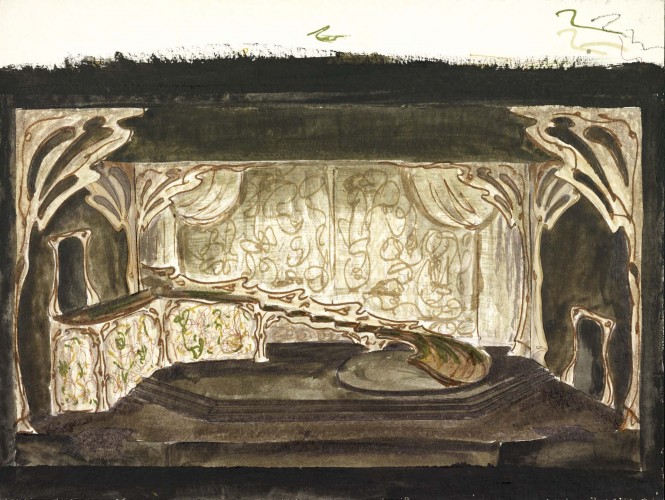
Set design for Cymbeline, ca. 1973.
Zelma Weisfeld Archive, 1954-2006.
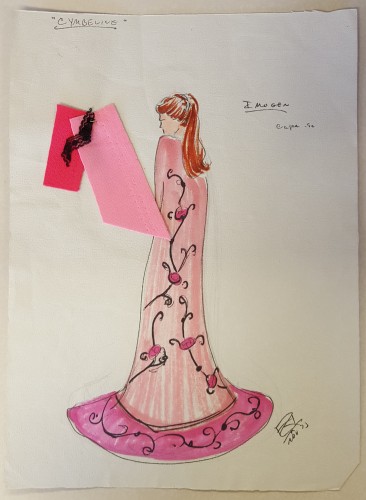
Costume design for Imogen in Cymbeline, ca. 1973.
Zelma Weisfeld Archive, 1954-2006.
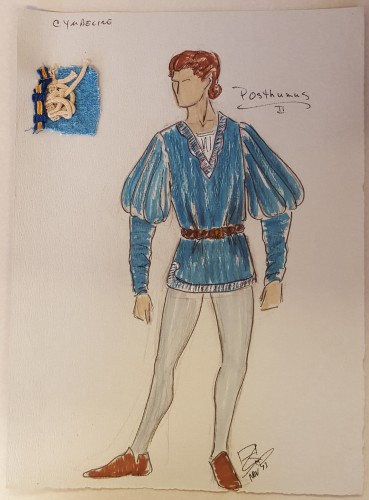
Costume design for Posthumus in Cymbeline, ca. 1973.
Zelma Weisfeld Archive, 1954-2006.
Weisfeld’s designs for the 1975 University of Michigan Professional Theatre Program's production of As You Like It, drew its inspiration from an entirely different aesthetic. As You Like It is a comedy in which the heroine flees in disguise from her uncle’s court to the Forest of Arden, where she and her cousin Celia meet a variety of eccentric characters and find love. Directed by Nicholas Pennell, this production placed the play in 1920s America and the Forest of Arden in Appalachia - certainly a riskier approach to Shakespeare than that chosen for Cymbeline. At least one reviewer in The Michigan Daily found the change in setting “distracting” and too much a stretch for suspension of disbelief. However, another review in Weisfeld's clipping file by Norman Gibson (publication title not available) reacted positively to the geometric scenery, jazz accompaniment, and overall relocation.
Either way, these costumes are interesting for their contrast to other examples of Weisfeld’s Shakespearean work, and also for their continuity. As with other productions, these designs support and visually outline key narrative contrasts. For example: the contrast between Rosalind and Celia’s glamourous evening gowns and the comically (and erotically) threadbare ensemble sketch of “Forest Ladies” not only lays out the contrast between country and court described in the play, but offers a sly critique of several characters’ romantacization of rural life.
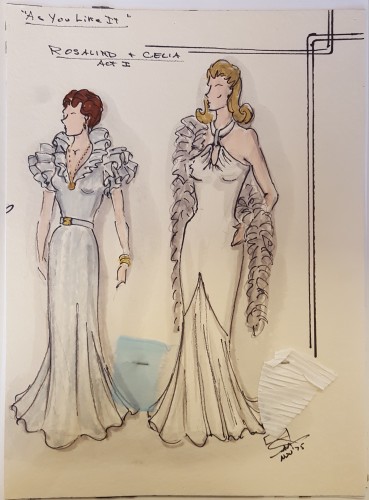
Costume designs for Rosalind and Celia in As You Like It, ca. 1975.
Zelma Weisfeld Archive, 1954-2006.
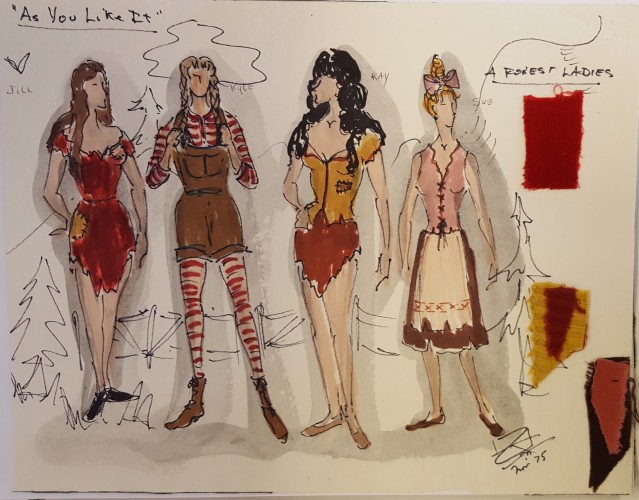
Costume designs for Arden Forest Ladies in As You Like It,
ca. 1975. Zelma Weisfeld Archive, 1954-2006.
As examples from one last Shakespeare production shows, Weisfeld was equally at home designing period costumes for historically-specific interpretations of Shakespeare. In the case of the University of Michigan Professional Theatre Program’s 1978 Richard II, in which the title role was played by Christopher Walken, she made use of color to queu the audience into through the symbolism behind the King’s character and to indicate shifting alliances over the course of the play.
Richard II functions as a prologue to Shakespeare’s epic of the War of the Roses. It is the first part of a historical tetrology, followed by three plays following the paths of Richard’s successors: Henry IV Part 1, Henry IV, Part 2, and Henry V. An important aspect of Richard II is that it celebrates the mystique of monarchy even while it raises questions about weak or ineffective incumbents. Weisfeld’s checklists show a royal color palate of gold, white, cream, and beige, contrasting with characters such as Bolingbroke in mundane blue and grey, or Jon of Gaunt in grey, black, and navy. It is also notable that Richard’s fabrics are mostly soft and textured, while Bolingbroke’s tend to be smoother, making sharper lines. As a final note, comparing King Richard's costumes to the archbishop as he appears in the ensemble costume sketch below, Weisfeld's choices, of color, fabric, and line clearly place both characters in priestly roles, reinforcing Richard's symbolic representation of the divine right of kings.
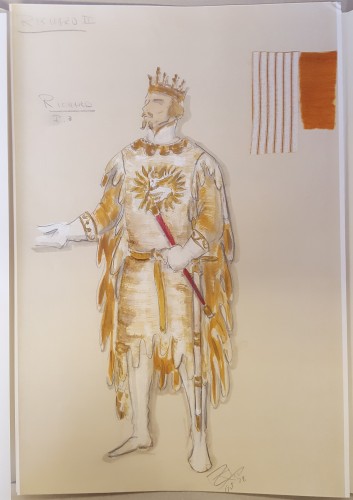
Color photocopy of costume design for the title character in King Richard II, ca. 1978. Zelma Weisfeld Archive, 1954-2006.
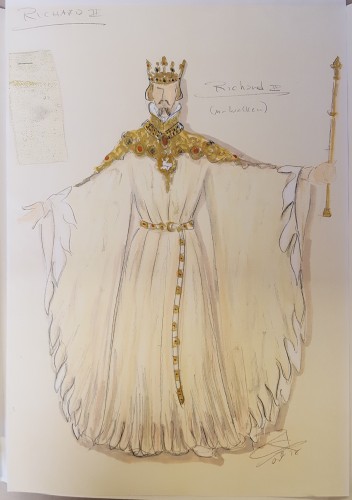
Color photocopy of costume design for the title character in King Richard II, ca. 1978. Zelma Weisfeld Archive, 1954-2006.

Ensemble costume design for King Richard II, ca. 1978. Zelma Weisfeld Archive, 1954-2006.